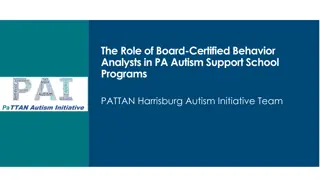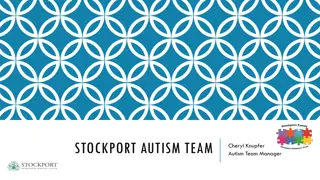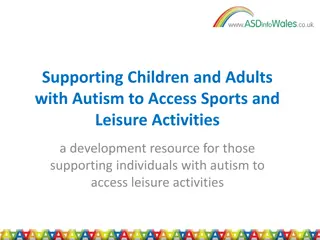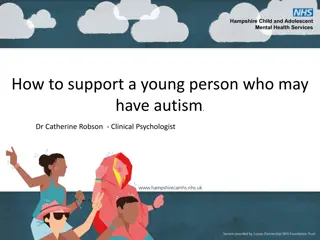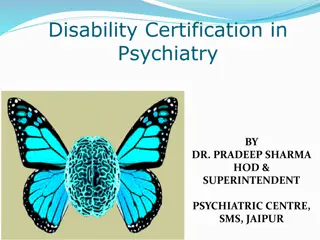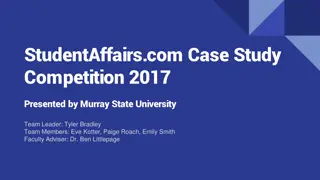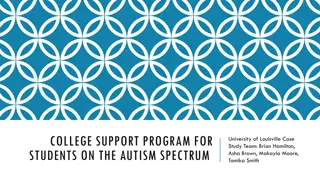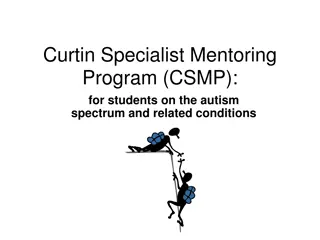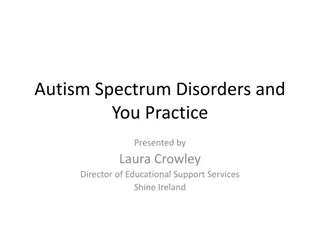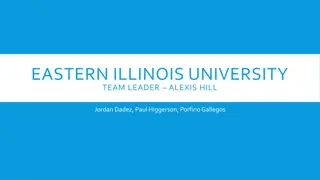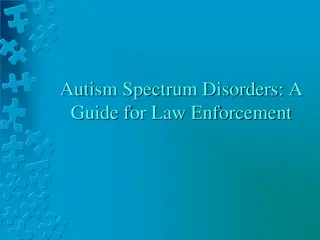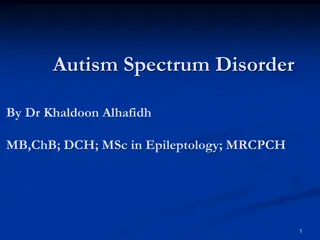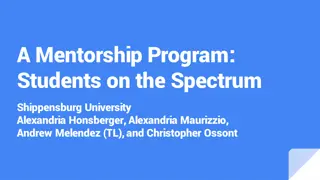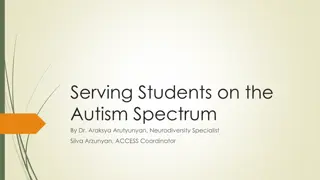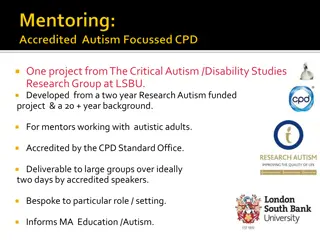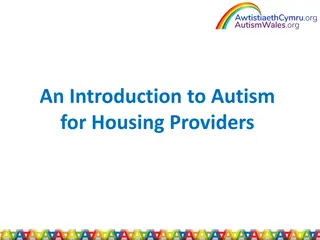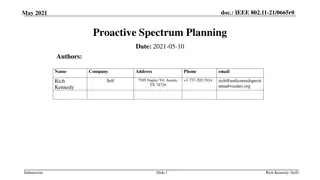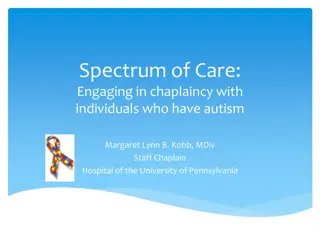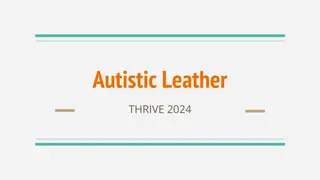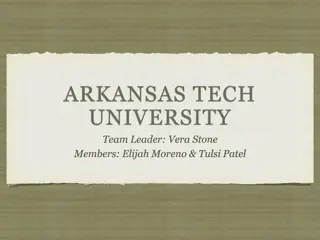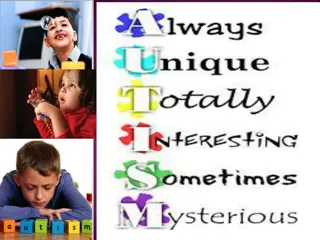Program for Autism Spectrum Students Integration
Challenges and recommendations for integrating students on the Autism Spectrum into the campus community, focusing on personal, social, and academic aspects. Challenges include struggles with establishing routines and increased risk of dropping out, while recommendations emphasize raising awareness, providing comfort zones, teaching life skills, promoting self-advocacy, and implementing support groups.
Uploaded on Mar 07, 2025 | 1 Views
Download Presentation

Please find below an Image/Link to download the presentation.
The content on the website is provided AS IS for your information and personal use only. It may not be sold, licensed, or shared on other websites without obtaining consent from the author.If you encounter any issues during the download, it is possible that the publisher has removed the file from their server.
You are allowed to download the files provided on this website for personal or commercial use, subject to the condition that they are used lawfully. All files are the property of their respective owners.
The content on the website is provided AS IS for your information and personal use only. It may not be sold, licensed, or shared on other websites without obtaining consent from the author.
E N D
Presentation Transcript
2017 StudentAffairs.com Virtual Case Study INDIANA STATE UNIVERSITY Nick Kight Kelly Anthony Danielle Stiles-Polk Cady Tabeling
Task at hand Develop a program aimed at providing personal, social, and academic integration into the campus community for students on the Autism Spectrum. Challenges and recommendations for students on the Autism Spectrum Personal integration Social integration Academic integration
Challenges to personal integration ASD students are taught to pass themselves off as normal (Cox et al., 2017) The core features and the psychiatric risks of ASD, coupled with new stresses and demands of higher education, pose significant challenges to students with ASD (Van Hees et al., 2014). ASD students are overwhelmed stepping into unfamiliar environments (Van Hees et al., 2014) Day-to-day activities required a lot of time and energy. The newer the activity and the more new activities needed to be taken into account and organized, the more students felt overwhelmed and the more their management of activities failed (Van Hees et al.,, 2014). ASD students struggle to establish a new routine (Van Hees et al., 2014) Although the numbers of students with disabilities are growing in post-secondary education, these students are also at the highest risk for dropping out of college (Sayman, 2015). ASD students are more likely to drop out of college (Sayman, 2015)
Recommendations to personal integration Change the campus climate and raise awareness of ASD across campus (Van Hees et al., 2014) Finally, there is a need for a better awareness among staff and students about ASD, and the way in which it can affect navigating in college. Awareness programs could help to break the current stereotypes, stigma and misunderstanding about students with ASD (Van Hees et al., 2014). Provide comfort zones for students with ASD (Cox et al., 2017) A single-room option as part of a larger community recognizes student independence while providing a transitional space to engage in communal activity (Cox et al., 2017). Teach ASD students life skills (Adreon & Durocher, 2007) Common daily living issues that may be problematic for some individuals with ASD include tending to personal hygiene, dressing properly, waking up to an alarm clock, getting to class on time, shopping, understanding meal plans and the rules for using them, using a campus ID, handling fire drills in the middle of the night, finding public restrooms, and acquiring transportation (Adreon & Durocher, 2007). Teach ASD students how to self- advocate (Sayman, 2015) Implement ASD student support groups (Van Hees et al., 2014) Students believed less strongly in group training and clearly preferred to exchange experiences with other students with ASD in a support group (Van Hees et al., 2014).
Social integration: Interaction with Peer Groups College students with autism often only disclose their disability to their peers when it is absolutely necessary (Cox et al., 2017). A negative experience with sharing their disability can make it difficult to continue sharing with peers (Cox et al., 2017). This can lead to peer groups not understanding the way in which the student with autism interacts with their college peers in dorms, classrooms, or on campus. Research has shown that students with autism would prefer to have positive social interactions with their peers, but their social skill deficits often lead to loneliness (Ashbaugh et al., 2017). Additionally, this can lead to students feeling isolated and spending typical social time alone and not interacting with other college peers (Ashbaugh et al., 2017). Most disability support services, currently, do not provide the much needed support focused on increasing socialization (Ashbaugh et al., 2017).
Social integration: Theory related to sexual identity development A student with autism who is working through their identity development is similar to that of a student working through their sexual identity development. Both are identity characteristics that are able to be hidden (Cox et al., 2017). Students with autism already are facing potential barriers to their ability to communicate and socialize as they are transitioning into adulthood (Ashbaugh et al., 2017). It is up to educators in the college and university setting to provide an environment that allows students to explore their own identities and where students feel safe disclosing their autism diagnosis (Cox et al., 2017).
Social Integration: Campus and social engagement In a recent study of college students with autism and their social experiences, half of participants indicated that they were intentionally not engaged or cautiously engaged with social events on campus (Colclough, 2016). More specifically, choosing to go to an event on campus is much more of a complex choice for students with autism. They must consider factors such as crowd size and noise (Colclough, 2016). Oftentimes, students with autism are very high functioning academically and may even perceive social events on campus as distractors from their educational purpose (Colclough, 2016). Some students have had success by identifying students they were familiar with in high school attending the same campus and thereby creating a very focused social circle (Colclough, 2016).
Social Integration: Peer mentors Peer mentors have been utilized successfully in modeling appropriate behavior and encouraging campus engagement beyond the classroom (Ashbaugh et al., 2017). Peer mentors can also be effective outlets for concerns or issues both socially and academically for students with autism (Colclough, 2016). Peer mentors can provide feedback from social activities that they attend with their matched student (Ashbaugh et al., 2017). Studies performed involving peer mentors have proven successful in encouraging students with autism to attend social activities and also to interact more with their college peers (Ashbaugh et al., 2017).
Academic Integration: Goals of Disability Student Services at Indiana State University To enable students with disabilities to participate in and benefit from university programs and activities by providing services. To ensure university s environment is free of both physical barriers and barriers of attitude. To encourage students with disabilities to become as independent and self-reliant as possible and to inform students that it is their responsibility to secure services and accommodations. To provide information and consultation about specific disabilities to entire campus community.
Academic Integration: Eligibility for disability services at Indiana State University Apply and be accepted for admission. Provide current and comprehensive documentation of a temporary or permanent disability that requires accommodation. Discuss specific needs and register for services by scheduling an appointment. Request services in a timely manner.
Academic Integration: Disability Student Services at Indiana State University Most requested services are additional time in written exams along with the following services: Extra preparation time for oral exams Separate room for taking exam Note-taking service Reading services Registration assistance Arrangement of interpreter service Letters of introduction to faculty
Academic Integration: Individualized College Plan (ICP) Because one of the most important aspects of transitioning to higher education begins with the fit of the student to the institution, the Individualized College Plan should outline academic modifications, independent living skills, socialization skills and goals, vocational goals, and mental health support (VanBergeijk et al., 2008). Transition plans should include exposure to the college curriculum while the student is still in high school.
PROPOSED PROGRAM: PUZZLE MASTERS Helping students with ASD put the pieces of college together.
Puzzle Masters: Program Objectives Designed as a cohesive program that follows individual students from acceptance through graduation. Educates participants and the campus community about Autism Spectrum Disorder. Offers an inclusive support system without isolation. Meets students where they are in their individual development and offers necessary resources.
Puzzle Masters: Participants Students with identified ASD and similar learning disabilities who are enrolled in the university and given the opportunity to opt-into the program and assigned to a peer mentor.
Puzzle Masters: Inclusion To create an immediate connection to campus, a peer mentor (selected from the graduate-level programs of psychology, education, and student affairs)will initiate contact with the student with ASD and the student s family to begin assessing student s needs and educate the student and family on availability of campus resources.
Puzzle Masters: Ongoing support Once on campus, the student with ASD meets with his or her peer mentor weekly to assist with the initial transition to campus. A peer mentor will be available to the student with an ASD throughout the student s college career and the relationship can be flexible as the needs of the student changes.
Puzzle Masters: Education A campus support group comprised of all students with ASD and their respective peer mentors will meet on a bi-weekly basis to offer a forum for open sharing and discussion regarding campus life. Support group will ideally provide an opportunity for the students to continue honing their social skills.
Puzzle Masters: Advocacy The support group will also provide an educational curriculum that offers education to the campus community and practical life skills education to the students with ASD.
Puzzle Masters: Proposed Yearly Budget Conferences Continuing education opportunities for program staff to remain aware of trends and needs within the ASD student population. Peer training Hiring of outside specialist to train peer mentors and program staff volunteers (specially from areas such as social work, psychology, and education). Curriculum and assessment Assessment and the evaluation of this program will allow us to make modifications as we measure the achievement of our outcomes. Events & activities Inclusion activities and education for the campus community. Supplies $1,000 $5,000 $500 $1,000 $500 TOTAL: $8,000
References Adreon, D., & Durocher, J. S. (2007). Evaluating the college transition needs of individuals with high-functioning autism spectrum disorders. Intervention of School and Clinic, 42(5), 271-279. Ashbaugh, K., Koegel, R. L., & Kern Koegel, L. (2017). Increasing social integration for college students with autism spectrum disorder. Behavioral Development Bulletin, 1-14. doi:10.1037/bdb0000057 Colclough, M. N. (2016). Exploring the social experiences of college students who have autism spectrum disorders: Examining neurodiversity on campus (Doctoral dissertation, Old Dominion University, 2016). Educational Foundations & Leadership Theses & Dissertations, Paper 6. Cox, B. E., Thompson, K., Anderson, A., Mintz, A., Locks, T., Morgan, L., Edelstein, J., & Wolz, A. (2017). College experiences for students with autism spectrum disorder: Personal identity, public disclosure, and institutional support. Journal of College Student Development, 58(1), 71-87. doi: 10.1353/csd.2017.0004 Gilson, C. B., & Carter, E. W. (2016). Promoting social interactions and job independence for college students with autism or intellectual disability: A pilot study. Journal of Autism & Developmental Disorders,46(9), 2831- 3194. doi:10.1007/s10803-016-2894-2 Sayman, D. M., (2015). I still need my security teddy bear: Experiences of an individual with autism spectrum disorder in higher education. The Learning Assistance Review, 20(1), 77-98. Van Hees, V., Moyson, T., & Roeyers, H. (2014). Higher education experiences of students with autism spectrum disorder: Challenges, benefits, and support needs. Journal of Autism & Developmental Disorders, 45, 1673-1688. Doi: 10.1007/s10803-014-2324-2 VanBergeijk, E., Klin, A., Volkmar, F. (2008). Supporting more able students on the autism spectrum: college and beyond. Journal of Autism & Developmental Disorders. 38(7):1359-1370.


